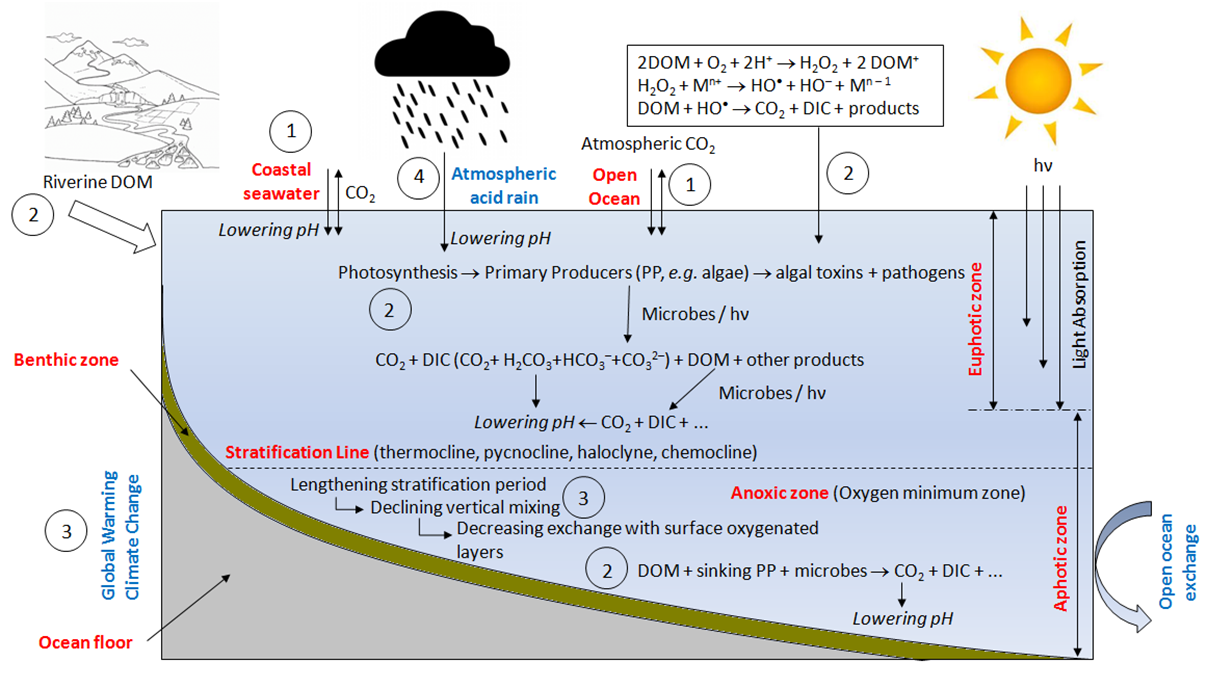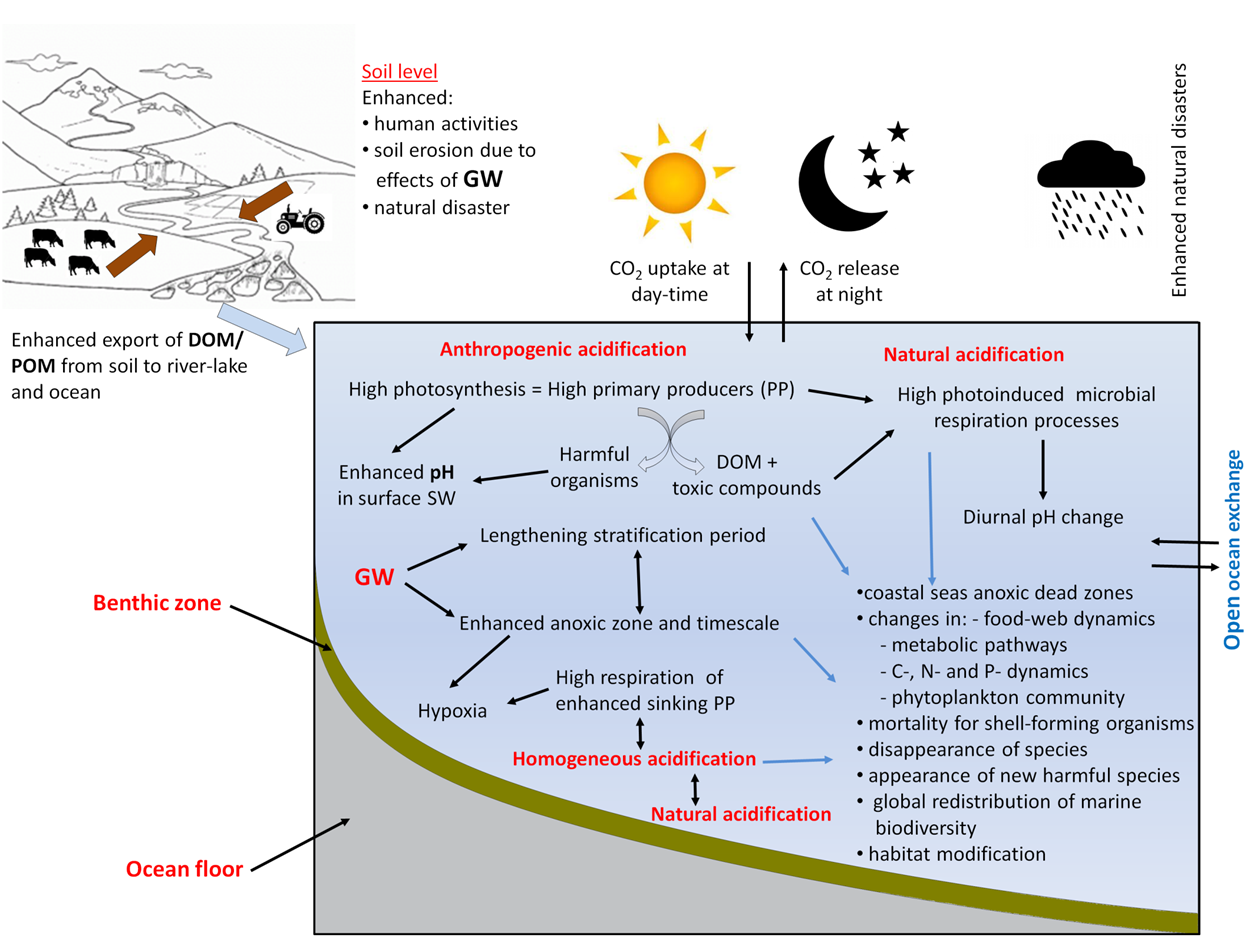Khan M. G. Mostofa
Marine ecosystems are adversely affected currently by ocean acidification, a complex phenomenon that lowers seawater pH, particularly changes in the marine chemistry and ecology. In fact, ocean acidificationis the net outcome of several contributions which includes several potential phenomena and may be operational at the global and/or local scales: (i) increasing dissolution of atmospheric CO2to seawater: anthropogenic ocean acidification; (ii) input of CO2plus DIC upon mineralization of PP influenced by elevatedatmospheric CO2: natural ocean acidification; (iii) enhancedPP and respiration due to the effects of global warming andother processes: natural ocean acidification; and (iv) directacidification and stimulation of PP by atmospheric acid rain:natural and anthropogenic ocean acidification. A pictorialscheme of the main operational processes affecting the oceanacidification is depicted in Figure 1.

Figure 1.A conceptual model of acidification in coastal to open oceans, showing either dissolution of atmospheric CO2or emission of aquatic CO2 plus DIC originated from the photoinduced and/or biological respiration of primary producers (PP). The latter includes bothdissolved organic matter (DOM) and PP (1). Uptake of such CO2 is primarily responsible for the occurrence of photosynthesis and PP (2)that can generate algal toxins or pathogens in the euphotic zone, along with generation of CO2, DIC, and other products; PP can also beenhanced by autochthonous DOM (2), by DOM or sinking cells in subsurface or deeper seawater (2), and by riverine DOM (2). Atmosphericacid rain (mostly HNO3 and H2SO4) can contribute directly to the acidification (3). Global warming can lengthen the stratification periodwith a subsequent decline in vertical mixing, which reduces the exchange with surface oxygenated water (4).
We discussed the mechanistic insights into the aforementioned processes and pH changes, with particular focus on processes taking place with different timescales. The pH changes are followed by three different approaches (diurnal, abrupt and homogeneous)whereas diurnal and abrupt pH changes caused by both photoinduced and biological processes (overlappingto diurnal changes)in the upper surface seawater. In contrast, homogeneous (longer-term and constant-rate) acidificationin subsurface/deeper seawateris characteristically observed in oceans. Enhanced primary production or algal blooms in surface seawater and the subsequentsinking are the key processes for homogeneous acidificationof the subsurface layer during the summer stratificationperiod, through the degradation of sinking organic material. The production of CO2 plusDIC (dissolved CO2, H2CO3, HCO3–, and CO32–) from the biological respiration/degradation of DOM and
PP by heterotrophic bacteria is responsible for homogeneous acidification. Such a homogeneous pH behavior is also followed in the subsurface water of a large freshwater lake. Homogeneous acidification can vary on a timescale of days to weeks or evenmonths in a wide range of subsurface water at a specific depth.
On the other hand, the impactsof increasing acidification on marine organisms may derivefrom several processes that are closely interlinked: (i) acidification,(ii) synergistic effects of acidification and oxidativestress in surface seawater, (iii) low dissolved O2 (hypoxia)and acidification in subsurface/deeper seawater, and (iv) stress by algal or red-tide toxins and pathogens.Seawater acidification or reducedseawater pH may produce undersaturation of aragoniteand calcite, with the following effects in a variety ofseawaters: (i) dissolution of biogenic shells or skeletons,mostly composed of CaCO3 in the form of calcite or aragonite,of adult marine calcifiers such as corals, crustose coralline algae, shellfish, marine plankton including foraminifera, and coccolithophores, mollusks, and echinoderms; sedimentaryCaCO3 would be affected as well. (ii) inabilityto form new shells or skeletons of framework builders by larvae or juvenile calcifiers(e.g., the larval and juvenile stages or smaller individuals),particularly at the early development stages.and (iii) oceanacidification could indirectly enhance heterotrophic bacterialactivities with increasing bacterial protein production andgrowth rate at elevated pCO2 levels. Other processes along with acidification drastically impacts on marine organisms.
Finally, an overview of the potential upcoming ecological and biogeochemical consequences, linking different environmentaldrivers, processes, and cycles related to acidification in thefuture ocean is provided in the Figure 2. The overall ecological and biogeochemical consequences of futureocean acidification under forthcoming global warming conditionsin oceans could severely impact coastal seas, with aspreading of anoxic dead zones and a frequent occurrenceof toxic dinoflagellate blooms (see Figure 2 for detailed description). For details, please read the article.

Figure 2.An overview of the potential upcoming ecological and biogeochemical consequences, linking different environmental drivers,processes, and cycles related to acidification in the future ocean.
Dr. Khan M. G. Mostofa from the Institute of Surface-Earth System Science, Tianjin Universityand his national/international collaborators conducted a study targeting onocean acidification and its potential impacts on marine ecosystems. This publication (Biogeosciences, IF = 3.978 in 2015)is an important outcome from a good international research collaboration getting data and other supports from distinguished collaborators of many institutions around the world. The related publications and reports in that regards are listed below.
Website: http://www.biogeosciences.net/13/1767/2016/bg-13-1767-2016.html
Reference:
Mostofa KMG, Liu CQ, Zhai W, Minella M, Vione D, Gao K, Minakata D, Arakaki T, Yoshioka T, Hayakawa K, Konohira E, Tanoue E, Akhand A, Chanda A, Wang B, Sakugawa H (2016) Reviews and Syntheses: Ocean Acidification and Its Potential Impacts on Marine Ecosystems. Biogeosciences13: 1767-1786